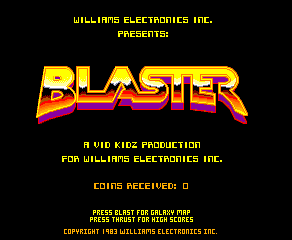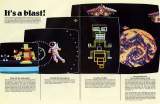

Blaster © 1983 Williams.
The player takes control of a spaceship and must fight against wave after wave of enemy fighters, while trying to rescue the stranded astronauts that represent the last surviving remnants of the human race. Enemies attack the player both with weapons, and by making 'suicide runs' at the player's ship. The game consists of eleven different levels, nine of which are repeated, bringing the total number of levels to 20.
The levels are : Planetoid Waves, Robot Grid Waves, Saucerland Waves, Vampire Waves, Time Tunnel Waves, Outer Space Waves, Enduro Waves, Cat World Waves, and Mastermind Waves (there are two of each of these).
There are also two unique waves that occur only once, they are Armageddon and Paradise.
Players can select their starting wave at the start of the game; choosing from Planetoids, Robot Grid, Saucerland, and Vampires. During the game, players must be careful to NOT shoot the human astronauts that drift through the levels. These must be rescued by 'running' into them.
Despite the presence of an energy meter, the player can take exactly three hits before he or she dies. Upon death, the window of the player's virtual cockpit breaks and one of the player's lives is lost. Blaster has a 'Continue' option but this can only be used once.

[1] [DuraMold model]
The DuraMold model was a large circular arcade cabinet made entirely out of thick plastic. These cabs were very attractive and almost impossible to damage. They were, however, expensive to produce and had a fatal design flaw : they shrank slightly in the first few months after they were made. In some cases the shrinking machine would eject its monitor, and send it flying across the room. Williams quickly developed a fix for this, but no one wanted DuraMolds after hearing about them shooting monitors across arcades. The DuraMold Blaster was all black and had yellow graphics on the control panel and marquee.
Dimensions : 72" (182.9cm) High x 29" (73.7cm) Wide x 31" (78.7cm) Deep
[2] [Upright model]
Dimensions : 70" (177.8cm) High x 24.5" (62.2cm) Wide x 26.5" (67.3cm) Deep
Weight : 270 lbs (122.5 kg)
[3] [Cockpit model]
Dimensions : 58.5" (148.6cm) High x 30" (70cm) Wide x 77.5"(198.9cm) Deep
Weight (uncrated) : 342 lbs (155kg)
Weight (crated) : 402 lbs (182.5kg)
Monitor (all models): 19" color raster non-interlaced.
CPU : 6809E
ROM : 232 Kilobytes
Video & Scratch RAM : 50 Kilobytes
CMOS RAM : 1kx4
Sound system : 2 Channel Stereo, 2 6808 Microprocessors
ROM : 8 Kilobytes (2 Systems)
Players : 2 (alternating)
Control : 49-Way optical joystick (6 separate speeds in 8 directions plus center off position)
Buttons : 2 (BLAST, THRUST)
Blaster was released internationally in November 1983.
Blaster was the official sequel to "Robotron: 2084", its attract mode went : The Robotrons have destroyed the last human family.
Dwayne Richard holds the record for this game with 92,346,500(!) points.
Originally known as 'Master Blaster', but they changed the name to avoid confusion with a pinball simulator called 'Bill Budges Raster Blaster' for the Apple computer. The 3-D effects of this game were all hand rendered which required thousands of hours of design work. Due to the expense of the pseudo-3D generating hardware, Blaster was released in very limited numbers.
Various copyright messages are hidden in the game's programming. They start off normal, then the weirdness starts. LED and EPJ are Larry DeMar and Eugene Jarvis respectively, the co-designers of this fine game.
At 0x18FB0:
COPYRIGHT 1983 VID KIDZ - ALL RIGHTS RESERVED.
At 0x29409:
COPYRIGHT 1983 VID KIDZ - ALL RIGHTS RESERVED.
LED - EPJ
At 0x2B282:
KEEPA YOU HANS OFFA MY PROAGRAMA
At 0x3046A:
BLASTER(TM)
BLASTER IS A TRADE MARK OF VID KIDZ
COPYRIGHT 1983 VID KIDZ - ALL RIGHTS RESERVED.
LED - EPJ
YOU TOUCHA MY PROGRAM - I BREAKA YOU FACE!
At 0x38A5F:
BLASTER(TM)
BLASTER IS A TRADE MARK OF VID KIDZ
COPYRIGHT 1983 VID KIDZ - ALL RIGHTS RESERVED.
SO THERE!
LED - EPJ

When Blaster was first put out at a test location in early 1983, it had 30 waves and allowed you to continue a game by spending another credit. By the time the game went into production in late 1983, the program had been modified to have 20 waves, and no buy-ins allowed.
1. Robotron: 2084 (1982, ARC)
2. Blaster (1983, ARC)
3. Robotron X [Model SLUS-00252] (1996, PSX)
4. Robotron 64 [Model NUS-NRXE-USA] (1998, N64)
Developed by: Vid Kidz
Staff : Eugene Jarvis (DRJ), Larry DeMar (LED), (JRS), (KLR), (DJW), Paul Dussault (PGD), (JER), (ALI), (MLG), (NHD)
CONSOLES:
Sony PlayStation (nov.30, 1997) "Arcade's Greatest Hits - The Midway Collection 2 [Model SLUS-00450]"
Sony PlayStation (mar.1998) "Arcade's Greatest Hits - The Midway Collection 2 [Model SLES-00739]"
Sony PS2 (nov.18, 2003) "Midway Arcade Treasures [Model SLUS-20801]"
Microsoft XBOX (nov.24, 2003) "Midway Arcade Treasures"
Nintendo GameCube (dec.18, 2003) "Midway Arcade Treasures [Model DOL-GAKE-USA]"
Microsoft XBOX (feb.6, 2004) "Midway Arcade Treasures"
Sony PS2 (feb.6, 2004) "Midway Arcade Treasures [Model SLES-51927]"
COMPUTERS:
PC [MS Windows 95, CD-ROM] (1997) "Arcade's Greatest Hits - The Midway Collection 2"
PC [MS Windows, CD-ROM] (aug.27, 2004) "Midway Arcade Treasures"
PC [MS Windows, CD-ROM] (nov.23, 2004) "Midway Arcade Treasures"
Game's ROM.
Game's picture.